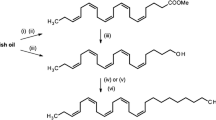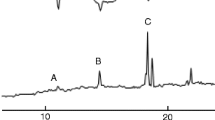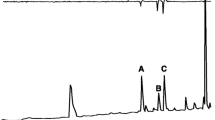Abstract
Three compounds have been identified as components of the sex pheromone emitted by females of the saltmarsh caterpillar moth,Estigmene acrea (Drury). These are (Z,Z)-9,12-octadecadienal (I), (Z,Z,Z)-9,12,15-octadecatrienal (II), and (Z,Z)-3,6-cis-9,10-epoxyheneicosadiene (III). In female tip extract they were found in a ratio of 1∶6∶25, respectively, and in trapped female effluvia the ratio was 1∶6∶27, respectively. Combinations of III with either I or II elicited sustained upwind flight in a wind tunnel, but none of these compounds by themselves did so. There is evidence that the antennal acceptor site for III is chiral.
Similar content being viewed by others
References
Beroza, M., andBierl, B.A. 1967. Rapid determination of olefin position in organic compounds in microgram range by ozonolysis and gas chromatography.Anal. Chem. 39:1131–1135.
Bierl, B.A., Beroza, M., andMcCollier, C.W. 1970. Potent sex attractant for the gypsy moth: Its isolation, identification and synthesis.Science 170:87–89.
Capella, P., andZorzut, C.M. 1968. Determination of double bond position in monounsaturated fatty acid esters by mass spectrometry of their trimethylsilyloxy derivatives.Anal. Chem. 40:1458–1463.
Cardé R.T., Doane, C.C., Baker, T.C., Iwaki, S., andMarumo, S. 1977. Attractancy of optically active pheromone for male gypsy moths.Environ. Entomol. 6:768–772.
Conner, W.E., Eisner, T., Vander Meer, R.K., Guerrero, A., Ghiringelli, D., andMeinwald, J. 1980. Sex attractant of an arctiid moth (Utethesia ornatrix): A pulsed chemical signal.Behav. Ecol. Sociobiol. 7:55–63.
Corey, E.J., andSuggs, J.W. 1975. Pyridinium chlorochromate. An efficient reagent for oxidation of primary and secondary alcohols to carbonyl compounds.Tetrahedron Lett. 31:2647–2650.
Downer, R.G.H. 1978. Chapter 2, Functional role of lipids in insects, pp. 58–92,in M. Rockstein (ed.). Biochemistry of Insects. Academic Press, New York.
Eglinton, G., Hunneman, D.H., andMcCormick, A. 1968. Gas chromatographic-mass spectrometric studies of long-chain hydroxy acids. III. The mass spectra of the methyl esters trimethylsilyl ethers of aliphatic hydroxy acids. A facile method of double bond location.Org. Mass. Spectrom. 1:593–611.
Farkas, S.R., Shorey, H.H., andGaston, L.K. 1974. Sex pheromones of Lepidoptera: Influence of pheromone concentration and visual cues on aerial odor-trail following by males ofPectinophora gossypiella.Ann. Enlomol. Soc. Am. 67:633–638.
Green, N., Jacobson, M., Henneberry, T.J., andKishaba, A.N. 1967. Insect sex attractants. VI. 7-Dodecen-1-ol acetates and congeners.J. Med. Chem. 10:533–535.
Hill, A.S., Cardé R.T., Bode, W.M., andRoelofs, W.L. 1977. Sex pheromone components of the variegated leafroller moth,Platynota flavedana.J. Chem. Ecol. 3:371–378.
Hill, A.S.,Kovalev, B.G.,Nikolaeva, L.N., andRoelofs, W.L. 1981. Sex pheromone of the fall webworm moth,Hyphantria cunea.J. Chem. Ecol. 6:Submitted.
Kennedy, J.S. 1977. Behaviorally discriminating assays of attractants and repellents, pp. 215–229,in H.H. Shorey, J.J. McKelvey, Jr., (eds.). Chemical Control of Insect Behavior— Theory and Application. Wiley-Interscience, New York.
Metcalf, C.L., Flint, W.P., andMetcalf, R.L. 1962. Destructive and Useful Insects, 4th ed., pp. 692–693. McGraw-Hill Book Co., New York.
Miller, J.R., andRoelofs, W.L. 1978. Sustained-flight tunnel for measuring insect responses to wind-borne sex pheromones.J. Chem. Ecol. 4:187–198.
Miller, J.R., Mori, K., andRoelofs, W.L. 1977. Gypsy moth field trapping and electroantennogram studies with pheromone enantiomers.J. Insect Physiol. 23:1449–1453.
Mori, K., Takigawa, T., andMatsui, M. 1979. Stereoselective synthesis of both enantiomers of disparlure, the pheromone of the gypsy moth.Tetrahedron 35:833–837.
Roelofs, W.L. 1977. The scope and limitations of the electroantennogram technique in identifying pheromone components, pp. 147–165in McFarlane (ed.). Crop Protection Agents, Academic Press, London.
Roelofs, W.L., andCardé R.T. 1971. Hydrocarbon sex pheromone in tiger moths (Arctiidae).Science 171:684–686.
Ryan, T.A. 1960. Significance tests for multiple comparisons of proportion, variances and other statistics.Psychol. Bull. 59:318–328.
Shorey, H.H., andHale, R.L. 1965. Mass-rearing of the larvae of nine noctuid species on a simple artificial medium.J. Econ. Entomol. 58:522–524.
Smith, R.G., Daterman, G.E., andDaves, G.D., Jr. 1975. Douglas-fir tussock moth: Sex pheromone identification and synthesis.Science 188:63–64.
Sonnet, P.E., andOliver, J.E. 1976. Olefin inversion. I. Reaction of aliphatic epoxides with triphenylphosphine dihalides.J. Org. Chem. 41:3279–3283.
Sweeley, C.C., Bentley, R., Makita, M.,andWells, W.W. 1963. Gas-liquid chromatography of trimethylsilyl derivatives of sugars and related substances.J. Am. Chem. Soc. 85:2497–2507.
Warthen, J.D., Jr., andJacobson, M. 1973. Insect sex attractants. XIV. All-trans-alkenol acetates, via sodium-liquid ammonia reduction.Synthesis 10:616–617.
Werner, R.A. 1977. Morphology and histology of the sex pheromone gland of a geometrid,Rheumaptera hastata.Ann. Entomol. Soc. Am. 70:264–266.
Author information
Authors and Affiliations
Additional information
Lepidoptera: Arctiidae.
Supported in part by the Rockefeller Foundation and by National Science Foundation Grants GB-38020 and PCM 78-13241.
Rights and permissions
About this article
Cite this article
Hill, A.S., Roelofs, W.L. Sex pheromone of the saltmarsh caterpillar moth,Estigmene acrea . J Chem Ecol 7, 655–668 (1981). https://doi.org/10.1007/BF00990299
Received:
Revised:
Issue Date:
DOI: https://doi.org/10.1007/BF00990299




